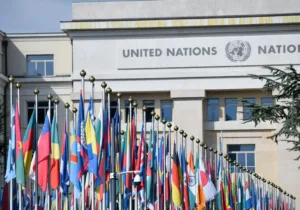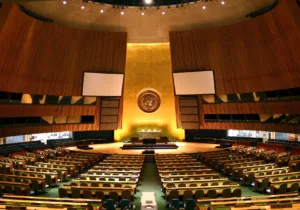From Kabul to Kiev, from the South China Sea to the Persian Gulf, from space to cyberspace, the U.S.-led international order is under relentless assault. That’s the bad news. The worse news may be that many Americans don’t appreciate how much America’s security and prosperity depend on the current international order.
Origins
Some call it the “rules-based democratic order,” others the “liberal international order.” These terms may seem esoteric, but they are just descriptions of how America and its allies have tried to make the world work since World War II: They developed rules and norms of behavior; encouraged democratic governance; promoted liberal (open, freedom-oriented) political and economic institutions; and called upon governments to live up to their responsibilities by promoting good order within and across their borders.
Contrary to those who dismiss the liberal international order as some gauzy outgrowth of 1990s-era globalism, it actually has deep historical roots. President Woodrow Wilson’s Fourteen Points sketched the broad outlines of a liberal order. A generation later, President Franklin Roosevelt and Prime Minister Winston Churchill unveiled the Atlantic Charter—their vision of the better world that could emerge from the rubble of World War II. Key American statesmen used this as the blueprint for a durable and just peace—and a more secure, more prosperous America.
In late 1945, Gen. George Marshall explained that “we fought to prevent Germany and Japan from imposing their kind of order on the world”—and that under what he called the “cooperative idea of global order,” America and its allies would defend “a set of rules for global conduct.”
President Harry Truman at the outset of the Cold War adopted a policy that committed America “to bring about order and justice by means consistent with the principles of freedom and democracy” and “to create a world society based on the principle of consent.” Toward that end, he forged NATO, rescued South Korea and West Berlin, signed on to the Universal Declaration of Human Rights, promoted GATT and other tariff-lowering initiatives, and fielded a large peacetime military to buttress the postwar order.
Likewise, President Ronald Reagan at the end of the Cold War committed the United States to defend “a peaceful, prosperous and humane international order.” Toward that end, he redoubled investment in deterrent military strength, renewed America’s commitment to NATO, wielded U.S. might to enforce international law in the Mediterranean Sea and Persian Gulf, used the bully pulpit and economic big stick to promote human rights in the Soviet bloc, and envisioned a North American free-trade zone.
Truman and Reagan recognized that the liberal international order sustains American power—and must be sustained by American power. As historian Robert Kagan explains, “International order is not an evolution; it is an imposition. It is the domination of one vision over others—in America’s case, the domination of liberal free market principles of economics, democratic principles of politics, and a peaceful international system that supports these over other visions.”
There are costs that come with sustaining the liberal international order. But the costs of a world that’s out of order are higher. And like a long-term investment, the benefits are greater than the upfront costs.
Costs
Consider the human costs. Before America and its allies began building the liberal international order, “Major powers frequently engaged in direct warfare on a massive scale,” as an Atlantic Council report explains. “Armed conflict killed an average of 1 to 2 percent of the human population from 1600 to 1945.”
Hundreds of thousands of Americans were among that number. More than 116,500 Americans were killed during World War I—in 588 days. America sacrificed 405,399 troops during World War II. Pointing to the 26,000 American troops killed in 47 days during the Great War’s Battle of Meuse-Argonne, the 57,000 American troops killed in an eight-week span in the summer of 1944, the 150 million people killed between 1914 and 1945, Chairman of the Joint Chiefs Gen. Mark Milley explains: “That’s what this international order that’s been in existence for seven and a half decades is designed to prevent.”
Indeed, as that Atlantic Council report details, after America began building and sustaining a liberal international order, there was a dramatic drop in lives lost: “During the Cold War, an average of 0.4 percent of the world’s population perished due to war. Since the year 2000, less than one one-hundredth of 1 percent of people have died this way.”
Related, the economic costs of great-power war are far higher than the economic costs of maintaining some semblance of order and great-power peace: In the eight years before entering World War I, the U.S. devoted an average of 0.7 percent of GDP to defense. During the war, the U.S. spent an average of 16.1 percent of GDP waging war. In the decade before entering World War II, the U.S. spent an average of 1.1 percent of GDP on defense. During the war, the U.S. spent an average of 27 percent of GDP waging war. During the Cold War, by contrast, Americans invested an average of 7 percent of GDP on defense. Those investments didn’t end all wars, but they did deter Moscow, prevent World War III, and preserve free markets and free government.
Because of the liberal order we have built, the cost of security is less today than in the past. In 1943, the cost of U.S. security was 36 percent of GDP; in 1953, 13.8 percent of GDP; in 1968, 9 percent of GDP; in 1982, 5.6 percent of GDP. The falling cost of security is a good thing. Americans spend less today on national security, as a percentage of GDP, than during the Cold War because the threat posed by the Soviet Empire is gone. However, in a still-dangerous world, we must remember that diminishing investments in national security will yield diminishing returns. With Russia on the march, China on the rise, the Korean Peninsula on edge and the Middle East on fire, we’ve reached that point.
At $857 billion projected for FY2023, the U.S. defense budget looks enormous. But looks can be deceiving. That figure represents just 3.2 percent of GDP. America’s Cold War average was more than twice that. If the 20th century taught us anything, it’s that shortchanging defense in the face of great-power threats never ends well.
The arguments made by voices on the left and right—“America has done enough for long enough,” “America is too good for the world,” “America can do no good in the world,” “time for nation-building at home,” “time to put America first,” “time for free-riding allies to lead”—may be appealing. But the hard truth is that nations which share our values don’t have the strength to promote an international order—and nations with the strength to promote an international order don’t share our values.
Chief among those values is what Providence’s editors and contributors, in their statementon faith and foreign policy, call “ordered liberty.”
The Free World naturally recoils from order without liberty, which is known as tyranny. But we sometimes forget that liberty without order is just as bad—it’s known as chaos—and that God is deeply interested in order. Genesis tells us God brought order out of chaos. Jeremiah says God “made the earth…and gave it order.” Paul writes, “God is not a God of disorder.”
In the international system they built after World War II, America and its allies offered a happy and healthy medium between a world of micromanaged tyranny and a world of savage chaos. “There is no perfect human political system,” the Providence statement concludes, “but we believe the liberal order is the least flawed of all presently available options and constitutes the best means for accomplishing the ends for which government was ordained.”
Benefits
As to the benefits side of the ledger, consider this comparison: In the 76 years before World War II—before the liberal international order took hold—America’s per-capita GDP increased by 136 percent. In the 76 years between the end of World War II and 2021—under the liberal international order—America’s per-capita GDP increased by 320 percent.
This increase in economic prosperity didn’t happen magically, organically or accidentally. It was the byproduct of the institutions, systems and guardrails of the liberal international order—and especially the stability and security represented by civilization’s first responder and last line of defense: the United States.
Consider U.S. defense expenditures earmarked for Europe. The International Institute for Strategic Studies estimates that over 5.1 percent of the U.S. defense budget (equaling $40 billion in FY2022) is devoted to European security. Again, that seems like a huge sum of money, but $40 billion represents just 0.17 percent of U.S. GDP. In exchange for that $40-billion investment, Americans get an outer ring of security, the ability to project power, sources of material and diplomatic support for U.S. leadership, a Europe not at war with itself, and a Europe reinforced against invasion (and an Indo-Pacific reinforced against invasion, thanks to similar investments in that region). In addition, age-old foes have the confidence to collaborate under the U.S. alliance umbrella, and nations that once were constant sources of conflict are now exporters of security. All of this militates against another great-power war that would cost Americans far more than $40 billion, far more than $857 billion.
If those benefits aren’t direct enough for those who shrug at the liberal international order, consider the vast trade and economic benefits that flow from these upfront investments in security: U.S. trade (in goods) with EU and NATO allies tops $1.56 trillion annually, with Japan, Korea, Australia, Taiwan and the Philippines $513 billion annually.
The “myth is that our allies are making us poor by free-riding on our military expenditures,” the late Gen. William Odom, former director of the National Security Agency, observed. “How are we to explain that the United States has gotten richer than its allies? Proponents of this argument cannot explain why. They fail to realize that our military alliances, by lowering transaction costs, have facilitated the vast increases in international trade from which the United States profits enormously. Our military costs should be seen as investments that pay us back.”
These investments in the liberal international order—a military capable of deterring war and ensuring open seas and open skies, a network of alliances serving as an outer ring of our security, a community of liberal democracies promoting peace, prosperity and ordered liberty—reflect America’s ideals and promote America’s interests. An international order led by Beijing, Moscow and other tyrant regimes will do the opposite.







 Live in the DC area? Sign-up for Providence's in-person events list!
Live in the DC area? Sign-up for Providence's in-person events list!